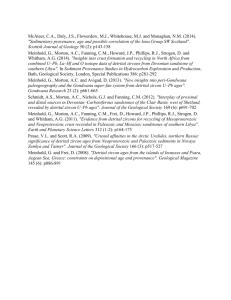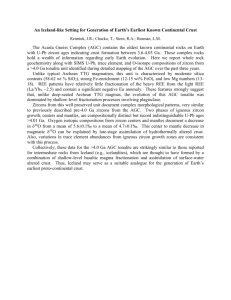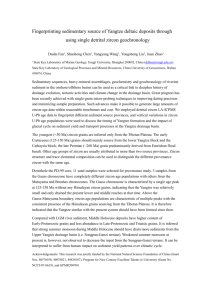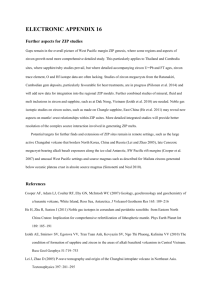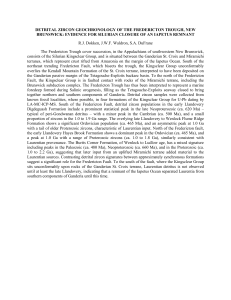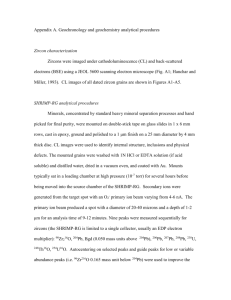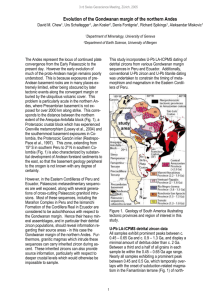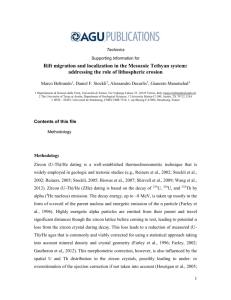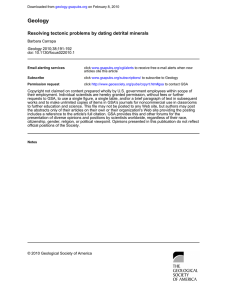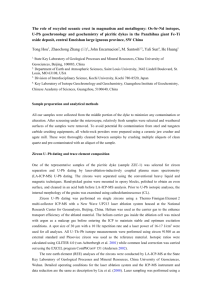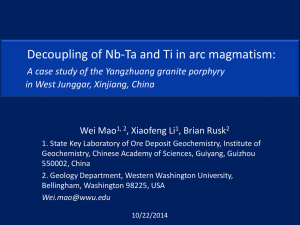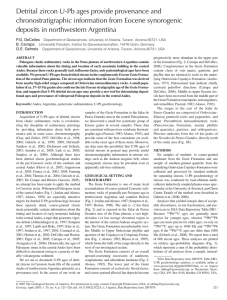bre12088-sup-0003-SupportingInfo
advertisement
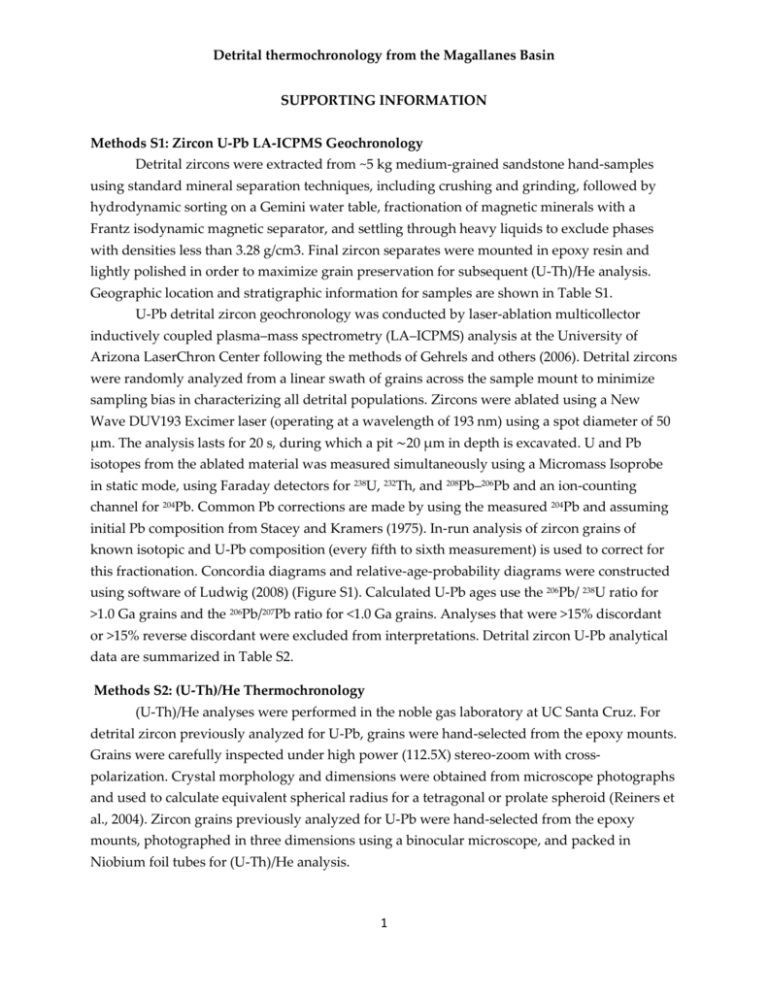
Detrital thermochronology from the Magallanes Basin SUPPORTING INFORMATION Methods S1: Zircon U-Pb LA-ICPMS Geochronology Detrital zircons were extracted from ~5 kg medium-grained sandstone hand-samples using standard mineral separation techniques, including crushing and grinding, followed by hydrodynamic sorting on a Gemini water table, fractionation of magnetic minerals with a Frantz isodynamic magnetic separator, and settling through heavy liquids to exclude phases with densities less than 3.28 g/cm3. Final zircon separates were mounted in epoxy resin and lightly polished in order to maximize grain preservation for subsequent (U-Th)/He analysis. Geographic location and stratigraphic information for samples are shown in Table S1. U-Pb detrital zircon geochronology was conducted by laser-ablation multicollector inductively coupled plasma–mass spectrometry (LA–ICPMS) analysis at the University of Arizona LaserChron Center following the methods of Gehrels and others (2006). Detrital zircons were randomly analyzed from a linear swath of grains across the sample mount to minimize sampling bias in characterizing all detrital populations. Zircons were ablated using a New Wave DUV193 Excimer laser (operating at a wavelength of 193 nm) using a spot diameter of 50 μm. The analysis lasts for 20 s, during which a pit ∼20 μm in depth is excavated. U and Pb isotopes from the ablated material was measured simultaneously using a Micromass Isoprobe in static mode, using Faraday detectors for 238U, 232Th, and 208Pb–206Pb and an ion-counting channel for 204Pb. Common Pb corrections are made by using the measured 204Pb and assuming initial Pb composition from Stacey and Kramers (1975). In-run analysis of zircon grains of known isotopic and U-Pb composition (every fifth to sixth measurement) is used to correct for this fractionation. Concordia diagrams and relative-age-probability diagrams were constructed using software of Ludwig (2008) (Figure S1). Calculated U-Pb ages use the 206Pb/ 238U ratio for >1.0 Ga grains and the 206Pb/207Pb ratio for <1.0 Ga grains. Analyses that were >15% discordant or >15% reverse discordant were excluded from interpretations. Detrital zircon U-Pb analytical data are summarized in Table S2. Methods S2: (U-Th)/He Thermochronology (U-Th)/He analyses were performed in the noble gas laboratory at UC Santa Cruz. For detrital zircon previously analyzed for U-Pb, grains were hand-selected from the epoxy mounts. Grains were carefully inspected under high power (112.5X) stereo-zoom with crosspolarization. Crystal morphology and dimensions were obtained from microscope photographs and used to calculate equivalent spherical radius for a tetragonal or prolate spheroid (Reiners et al., 2004). Zircon grains previously analyzed for U-Pb were hand-selected from the epoxy mounts, photographed in three dimensions using a binocular microscope, and packed in Niobium foil tubes for (U-Th)/He analysis. 1 Detrital thermochronology from the Magallanes Basin Helium gas extraction on detrital zircons was conducted at UC Santa Cruz using a 908 nm laser diode system. The sample gas was spiked with 1x10-13 moles of 3He, purified with a SAES ST101 50 l/s getter, and cryogenically transferred to and analyzed by a Pfieffer Vacuum™ Prisma quadrupole mass spectrometer. The extraction process was repeated until >99% of the He had been liberated from the zircon. Procedural blanks and 4He/3He standard gas were periodically run to assess backgrounds and 4He/3He fractionation. Degassed zircons were hydrothermally dissolved at 225°C in 200 μl microcapsules contained within a 125 mL Parr bomb assembly following an unpublished protocol modified after Reiners et al. (2006). Parent U and Th isotopes were measured on a Finnigan X-Series ICPMS. Standard analysis of Fish Canyon Tuff zircon (27.8 Ma eruptive age) yielded an alphaejection corrected weighted mean age of 28.9 ± 2.6 Ma (n = 57) for the duration of the sample analyses. On the basis of these and other laboratory standards, we estimate 7% (2σ standard error) uncertainty on expected ages. Age calculations were done with an in-house data reduction package that applies an alpha-ejection correction (Ft) to derive final (U-Th)/He dates that account for diffusion-domain-dependent loss of the daughter nuclide (Reiners et al., 2004). Measured ages were corrected for alpha-ejection for tetragonal and prolate spheroid geometries (Reiners et al., 2004). Zircon (U-Th)/He results are reported in Table S3. Methods S3: Forward modeling of He thermochronology data The following appendix contains detailed input parameters and graphs used in the numerical thermal modeling of the detrital zircon thermochronology data from the Magallanes Basin, Southern Andes. Modeling parameters for each sample, described in Table S4 correspond to the constraints shown conceptually in Figure 9 of the manuscript text. Cumulative probability distributions of modeled (U-Th)/He dates (He) for acceptable and good fit thermal models are shown with measured ages in Figure S2. The K-S test is sensitive to overall differences in both age and magnitude of sample cumulative distributions, does not assume normal distributions, and is commonly used for comparing age distributions in detrital studies. Here we use it to evaluate similarity between measured age distributions and modeled results. We report thermal history results for He date distributions that fit measured data to with probability values >0.68 (acceptable-fit) and >0.94 (best-fit) numerical significance in the K-S test. Note that this reflects only an ad hoc measure of goodness-of-fit for the model and measured distributions and does not convey the probability that the distributions are equivalent. As constructed, the K-S test is only capable of demonstrating that two distributions are dissimilar if the K-S statistic falls below a specified confidence level. For example, 95% confidence in the K-S test corresponds to a value of the K-S statistic of 5%. Values of the statistic higher than 5% are indistinguishable in terms of probability. 2 Detrital thermochronology from the Magallanes Basin Methods S4: Estimated Paleogene sedimentation and erosion rates We estimate plausible sediment accumulation rates during deposition of the hypothesized ~5 km of stratigraphic overburden above the Maastrichtian Dorotea Formation. Using the approximation method of Van Hinte (1978) for calculating the original thickness 𝑇𝑜 : [(1 − Φ𝑛 ) × 𝑇𝑛 ] 𝑇𝑜 = (1 − Φ𝑜 ) with porosity Φ𝑜 , a compacted overburden thickness 𝑇𝑛 with porosity Φ𝑛 , and coefficient of porosity 𝑐, where: Φ𝑛 = Φ𝑜 𝑒(−𝑐𝑧) For simplicity we do not include a component of water loading and assume that sediments were deposited in a shallow marine or continental environment. A decompacted sedimentation rate 𝑆 is calculated by dividing the original thickness 𝑇𝑜 by time since deposition and peak heating 𝛥𝑡 for two difference scenarios of peak heating at 54 Ma and at 46 Ma: 𝑇𝑜 𝑆= 𝛥𝑡 Estimates of decompacted sedimentation rate range from 0.3- 0.5 mm/yr (Table S5). In a similar manner, first-order erosion rates from peak heating to deposition of overlying Man Aike/Río Turbio Formation (Table S5). Estimated erosion rates are between 0.5 and 2.7 mm/yr for the time between peak burial heating and ca. 44 Ma deposition of the overlying units. Supplementary Tables and Figures Figure S1. Tera-Wasserburg Concordia diagrams for zircon U-Pb data for sample 09-208 (A, B), sample 09-226 (C, D), sample 09-230 (E, F), sample 09-235 (G, H), and sample 09-207 (I, J). All plots were made with Isoplot (Ludwig, 2008). Figure S2. Cumulative probability distributions for modeled zircon He dates calculated from best-fit thermal histories. A) Maastrichtian Dorotea Formation (samples 09-208 and 09-226). B) Miocene Santa Cruz Formation (for > 65 Ma grains from samples 09-235 and 09-207). Best-fit distributions are shown for thermal models that pass the Kolmogorov-Smirnoff statistical test (K-S) with probability values >0.68 and >0.95 compared to cumulative distribution of He dates. Table S1. Sample location information for detrital zircon thermochronology samples. Table S2. Detrital zircon U-Pb geochronologic analyses by LA-ICP-MS analysis. The * indicates radiogenic Pb (corrected for common Pb). All errors are reported at the 1σ level. Table S3. Combined zircon U-Pb and He data from subset of selected detrital zircons. Ft is the alpha-ejection correction after Farley (2002). Samples in italics indicate discordant grains that are not included in probability distribution calculations. Table S4. Thermal modeling input parameters for calculating forward modeled He dates. Table S5. Parameters used for decompacted sedimentation and erosion rates. 3
